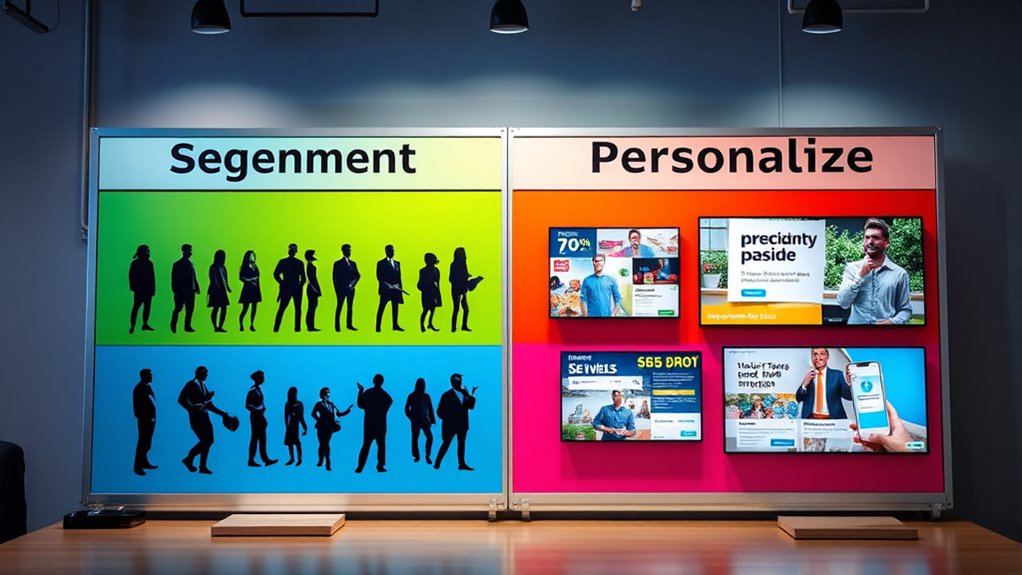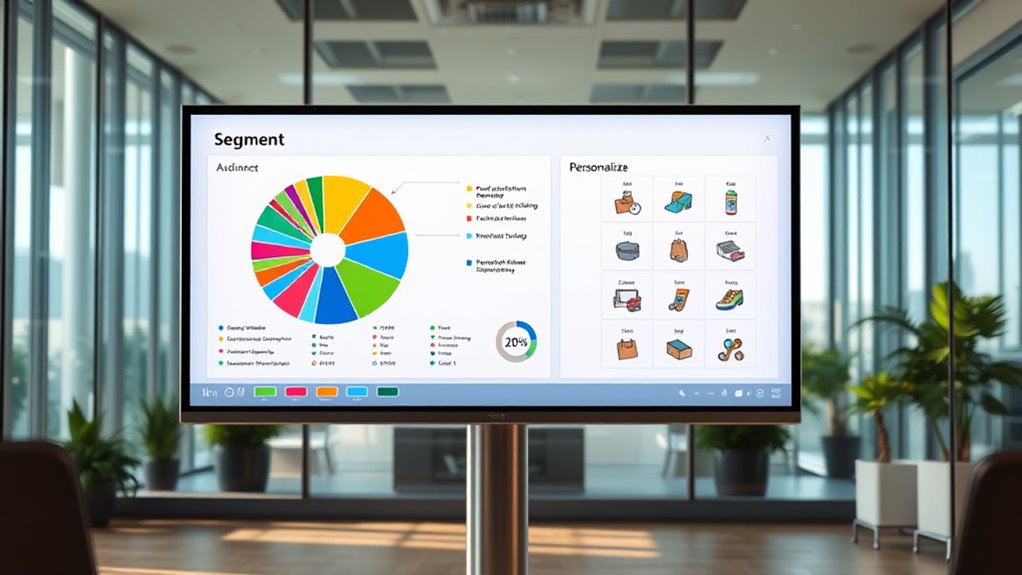Segmentation divides your audience into groups based on shared traits like demographics or psychographics, helping you target specific customer needs. Personalization, on the other hand, tailors content or experiences to individual preferences using data about their behaviors. While segmentation focuses on broad groups, personalization zeroes in on individual customer details. Understanding the difference helps you craft more effective marketing strategies. If you want to learn how to combine both effectively, stay with us for more insights.
Key Takeaways
- Segmentation groups audiences into shared traits, while personalization tailors content to individuals within those groups.
- Segmentation identifies target segments; personalization delivers customized experiences at the individual level.
- Misusing these terms often leads to ineffective marketing strategies and confusion about target approaches.
- Combining segmentation and personalization enhances relevance, engagement, and long-term customer loyalty.
- Clear differentiation is essential: segmentation is about “who,” personalization is about “what” and “how.”
Defining the Core Concepts

Understanding the differences between segmentation and personalization is essential for effective marketing. Segmentation involves dividing your audience into groups based on shared characteristics, like demographic segmentation, where you identify age, gender, income, or education level. Psychographic targeting goes deeper, focusing on lifestyles, values, interests, and personality traits. These methods help you craft strategies tailored to specific segments, ensuring your message resonates. Personalization, on the other hand, takes it a step further by customizing content for individual consumers. Instead of broad groups, you adapt your messaging based on unique preferences and behaviors. Recognizing these core concepts helps you allocate resources effectively and deliver more relevant, engaging experiences for your audience. Understanding different tableware materials can further enhance the personalization of your dining experiences.
The Purpose Behind Segmentation

The primary purpose of segmentation is to identify distinct groups within your audience so you can tailor your marketing efforts more effectively. By understanding customer grouping, you can develop targeted messaging that resonates with each segment’s specific needs, preferences, and behaviors. Segmentation helps you avoid one-size-fits-all campaigns, allowing you to focus your resources on the most promising groups. This approach increases engagement, improves conversion rates, and enhances customer satisfaction. It also enables you to craft relevant offers and communication strategies that speak directly to each segment’s motivations. Ultimately, segmentation helps you deliver more personalized experiences at scale, ensuring your marketing efforts are precise, efficient, and impactful. Incorporating divergent thinking can further inspire innovative ways to approach audience segmentation and engagement strategies.
The Role of Personalization in Marketing

Personalization plays a essential role in modern marketing because it allows you to connect with your audience on a deeper level. By analyzing customer behavior and leveraging data analysis, you can craft tailored experiences that resonate with individual preferences. Personalization helps you deliver relevant content, offers, and messaging, increasing engagement and loyalty. When you understand what motivates your customers, you can anticipate their needs and respond proactively. This targeted approach not only improves the customer journey but also boosts conversion rates. Effective personalization requires ongoing data collection and analysis to refine your tactics continually. Additionally, understanding the offensive security techniques used by ethical hackers can help you better protect your personalized content from cyber threats. Ultimately, it transforms generic marketing into meaningful interactions that make your audience feel valued and understood, strengthening your brand’s relationship with each customer.
Common Mistakes and Misconceptions

Many marketers mistake segmentation for personalization, thinking they are interchangeable when they serve different purposes. It’s also common to misunderstand what each strategy aims to achieve, leading to ineffective campaigns. Overgeneralizing these approaches can cause missed opportunities to truly connect with your audience. For example, fostering a digital literacy environment at home is essential for nurturing future innovation skills.
Confusing Segmentation With Personalization
Are marketers often mixing up segmentation with personalization? It’s a common mistake. Audience segmentation groups your audience into broad categories based on shared characteristics, like demographics or behaviors. Personalization tactics, on the other hand, tailor content or offers to individuals within those segments, creating a more relevant experience. Confusing the two can lead to ineffective campaigns, where you either send generic messages or try to personalize without proper segmentation. Remember, segmentation lays the foundation for personalization. Without it, personalization efforts may miss the mark or seem inconsistent. To avoid this, clearly differentiate your audience segments first, then implement personalization tactics within each group. This distinction ensures your marketing efforts are targeted, relevant, and more likely to engage your audience effectively. Embracing audience insights can further enhance the effectiveness of your segmentation and personalization strategies.
Misunderstanding Term Purposes
Understanding the true purpose of segmentation and personalization is essential, yet many marketers misinterpret these terms, leading to ineffective strategies. Common mistakes include:
- Believing customer segmentation is solely about demographics, ignoring behavior and preferences.
- Using personalization to target everyone equally, instead of tailoring messages to individual needs.
- Assuming that segmenting automatically guarantees personalized marketing success.
- Confusing broad segmentation with highly targeted personalization, resulting in generic campaigns.
These misunderstandings dilute your efforts and reduce engagement. Customer segmentation aims to group similar customers for more relevant messaging, while personalized marketing focuses on customizing content for individual preferences. Recognizing these distinctions helps you develop smarter, more effective strategies that resonate with your audience.
Overgeneralization of Strategies
Overgeneralizing strategies often leads marketers to apply the same tactics across diverse customer segments without considering their unique needs and behaviors. Relying solely on demographic targeting can cause you to overlook important differences within groups, reducing effectiveness. Instead, you should focus on content customization that addresses specific preferences and pain points. Avoid the mistake of treating all customers as a monolith; each segment may require tailored messaging and offers. Overgeneralization limits your ability to connect meaningfully and can decrease engagement. Instead, analyze the distinct characteristics of your audience, and adapt your strategies accordingly. Incorporating Nike Tech innovations can help create targeted campaigns that resonate with specific consumer groups. By refining your approach with precise segmentation and personalized content, you’ll foster stronger relationships and improve overall campaign success.
Practical Applications and Examples

When implementing segmentation or personalization strategies, practical applications can vary widely across industries. For example, in retail, customer segmentation helps target specific groups with tailored offers, boosting sales. In digital marketing, content personalization ensures users see relevant content, increasing engagement. Here are some common applications:
- Segment email lists based on purchase history for targeted campaigns.
- Personalize website experiences by displaying products aligned with browsing behavior.
- Use customer segmentation to send customized promotions during holidays.
- Tailor social media ads to specific demographics for higher conversion rates.
- Understanding color accuracy in projectors can enhance visual appeal and viewer satisfaction.
These applications demonstrate how customer segmentation enables precise targeting, while content personalization enhances user experience. Both approaches make your marketing efforts more relevant, leading to improved customer loyalty and higher ROI.
Strategies to Effectively Combine Both Approaches

To effectively combine segmentation and personalization, you need a strategic approach that leverages the strengths of both methods. Start by mapping the customer journey to identify key touchpoints where targeted segmentation can be most impactful. Use data integration to gather detailed insights from various sources, ensuring your segments are accurate and dynamic. Then, tailor your messaging within each segment by personalizing content based on individual behaviors and preferences. This blended approach allows you to deliver relevant experiences at each stage, increasing engagement and conversions. Continuously analyze and refine your segments and personalization tactics, ensuring they evolve with customer needs. By aligning segmentation with personalized messaging throughout the customer journey, you create a seamless experience that maximizes relevance and effectiveness.
Frequently Asked Questions
How Do Segmentation and Personalization Differ in Digital Marketing?
In digital marketing, you might wonder how segmentation and personalization differ. Segmentation involves customer profiling and dividing your audience into groups based on shared traits, allowing targeted messaging. Personalization takes it a step further, tailoring content to individual preferences within those segments. You use audience segmentation to identify groups, then personalize your messaging to make each customer feel uniquely valued and engaged, enhancing your marketing effectiveness.
Can Segmentation and Personalization Be Used Simultaneously?
Imagine you’re a chef crafting a meal; you select ingredients based on your guests’ tastes. Similarly, you can use data segmentation to group customers by behavior targeting, then personalize messages within those groups. Yes, segmentation and personalization work hand-in-hand, enhancing marketing precision. By combining data segmentation with behavior targeting, you create tailored experiences that resonate deeply — making each customer feel uniquely valued without missing the bigger picture.
What Are the Key Benefits of Combining Both Strategies?
By combining segmentation and personalization, you can boost customer loyalty and improve content relevance. Segmentation helps you group your audience based on shared traits, while personalization tailors messages to individuals. Together, they create a more targeted experience that resonates with your customers, making them feel understood and valued. This approach increases engagement, encourages repeat business, and ultimately strengthens your relationship with your audience.
How Do Businesses Measure the Success of Segmentation?
Ironically, measuring segmentation success isn’t as mysterious as it sounds. You’ll want to rely on customer profiling and data analysis to see how well your segments respond to campaigns. Track metrics like engagement, conversion rates, and customer lifetime value. If your targeted groups show improved loyalty and sales, you’ve nailed it. Success means your segmentation strategy effectively aligns with customer needs, making your efforts quantifiable and impactful.
Which Industries Benefit Most From Personalization Tactics?
You’ll find that industries like retail, e-commerce, and hospitality benefit most from personalization tactics. By using customer segmentation and behavioral targeting, you can tailor experiences to individual preferences, increasing engagement and loyalty. These tactics help you deliver relevant offers and content, making customers feel valued. Personalization is especially effective in competitive markets, where understanding customer behavior directly boosts your conversion rates and overall satisfaction.
Conclusion
Understanding the difference between segmentation and personalization helps you craft more targeted marketing strategies. Did you know that personalized emails deliver six times higher transaction rates? By combining both approaches effectively, you can engage your audience more deeply and boost your results. Remember, clarity in these terms guarantees your efforts aren’t wasted, and your campaigns resonate. Embrace these strategies to stay ahead in a competitive landscape—your customers will notice the difference.
Natali – Editor in Chief (Strategy and Mastery, AI Expert) Natali, our Editor in Chief, is the driving force behind our content’s strategic direction. With a keen eye for detail and a deep understanding of market trends, Natali ensures that our content is top-notch and strategically aligned with our client’s goals. Her expertise in AI helps to seamlessly integrate advanced technology into our marketing strategies, pushing the boundaries of conventional marketing.










